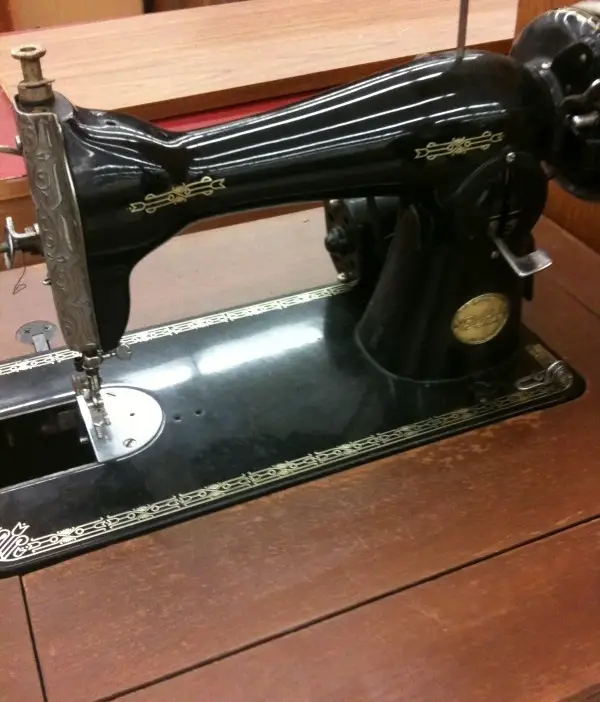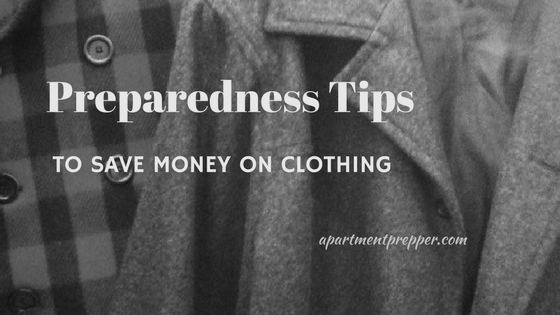This post is by Bernie Carr, apartmentprepper.com
I received a great email from reader Linda who brought up an important aspect of preparedness: clothing. Well-made clothes can be expensive, yet necessary for survival. If there is some kind of large-scale collapse, manufacturing and shipping may be interrupted, and clothes will be scarce.
During the Great Depression, many people could not afford store-bought clothes and therefore had to make their own. Many had to trade items for materials or cloth or used burlap sacks that chicken feed came in. Fortunately for them, they knew how to sew, but how many of us at the present time can make an actual outfit? I can sew a basic hem or reattach a button, but I can’t say I could make an article of clothing. The scarcity of clothes continued for many years. Even during World War II, clothes and shoes were rationed along with other commodities such as fuel, coffee, tires, cheese, meat, etc. Clothes could be only during certain days, and by buying through the black market at steep prices.
Clothes will wear out and will need to be replaced, and kids will outgrow their clothes. Even if nothing happens, if you stock up on inexpensive clothes now, you will be glad to have them when prices are higher. Of course, fashion-conscious folk will have to give up having the latest styles, but at that point, people would just be glad to have something to wear.
Save money on clothing
- Shop in your own closet and set aside a few pairs of jeans, sturdy clothing for your “bug-out” bag. Have a set for different seasons. Choose comfortable shoes as well.
- Give away or sell clothes and shoes you no longer use to make room.
- Go through your kids’ clothes and do the same thing. Sell or give away outgrown items. Make extra money by taking their used clothes to a resale shop.
- If you know families who have kids who are close in ages, set up a hand-me-down exchange.
- Visit Goodwill and other thrift stores and shop for clothes of varying sizes in anticipation of kids’ growth spurts. Take advantage of “buy one get one free” or “buy one get one at half off” days.
- Buy quality items that last for a long time. Readers like 5-11 clothing because of their durability.
- If you have the room, keep a few clothes for barter.
- Buy classic styles that are well made and will look good for a long time.
- Have some repair materials on hand such sewing kit, zipper repair, sewing awl, (used to repair heavy duty items such as thick jackets, sleeping bags, tents etc) Shoe Goo, heel savers on hand.

- To get started, choose one skill that will help you create clothing in the future: sewing, crocheting, quilting or knitting are all good to know. I recently started learning how to crochet from an elderly neighbor who started a needle and crochet group. You can also learn by watching YouTube videos.
- Take a free class at a sewing machine seller, or have a friend show you how.
- Stock up on materials by buying them on sale at discount stores or thrift stores.
Make your clothes and shoes last longer
- See Basic Shoe Care for tips on how to make your shoes last.
- Wash colors in cold water and 1/3 cup vinegar rinse. The vinegar sets the color and does not impart the vinegar smell.
- Turn clothes inside out before washing.
- If you have the room, line dry clothes. Drying in a clothes dryer wears them out faster-this is where lint comes from.
- Take care of stains right away. Hydrogen peroxide is a good stain remover for organic stains such as blood. Rubbing alcohol works well on ink and grass stains.
- Many items of clothing (except for underwear) really do not need to be washed after every wear. Unless you sweat heavily or live in a hot, humid climate year round, your clothes stay fairly clean wearing a couple of times between washes. Just hang them up to smooth out wrinkles.
Storage
- Stains and body oils attract moths and other bugs. Store only clean clothes – wash and dry all clothes prior to storing.
- Fold clothes properly as best you can.
- Plastic under the bed storage bins are good; space bags also work well for clothing.
- Toss a used dryer sheet to avoid musty odors.
- Store in clean, dry places. Moisture will cause mold and mildew to form and ruin the clothes.
- Use cedar hangers or cedar chips to repel moths. Mothballs not only smell bad, but they also contain harmful chemicals. Other natural moth repellants include lavender, rosemary, eucalyptus. In a future post, I will cover how to make how to make natural sachets that repel insects.
About the author:
Bernie Carr is the founder of Apartment Prepper. She has written several books including the best-selling Prepper’s Pocket Guide, Jake and Miller’s Big Adventure, The Penny-Pinching Prepper and How to Prepare for Most Emergencies on a $50 a Month Budget. Her work appears in sites such as the Allstate Blog and Clark.com, as well as print magazines such as Backwoods Survival Guide and Prepper Survival Guide. She has been featured in national publications such as Fox Business and Popular Mechanics. Learn more about Bernie here.
For more preparedness tips, read my book:



Hi j.r., Thanks for the link to those Fire Hose pants-they look really sturdy and look great too. I am adding some to the Christmas gift list. I appreciate the comment.
These pants are great! I use them now for protective gear when riding my motorcycle…and they are tough as nails…They’re a bit stiff, but that’s probably because I don’t wear them for everyday use. I’d guess they’ll last for years!
Greg W. Now I really want a pair. Thanks for the review.
Hi countrygirl, Sounds like you already have a system set up! I was impressed at the warm clothes selection at the goodwill I visited. I am stocking up as well. Thanks for the comment.
I have purchased many quality items at Good Will and Salvation Army stores. I look for quality not fashion I have purchased 6 Eddy Bauer goose down jackets for family members and never paid more that $12.00. I have also purchased sleeping bags for them as well. Just a hint on any clothing item purchased at a thrift store all ways run it through a hot direr cycle 1st thing. This will kill and bugs in the items. Than wash or dry-clean as needed.
You can score some good quality items at thrift stores but always wash thoroughly as you said. Thank you!
FYI just washing an item will NOT kill bed bugs. The hot water is not a high enough temp. That is why you need to run it through a full high heat dryer cycle 1st thing. DO NOT bring an unbag item in to your apartment before it has gone through a full high heat dryer cycle. I keep new garbage bags in my cat to put any cloth item in to and tie it closed before I have cycled it. Than wash or dry-clean as needed.
I really like you web articles and find them usefull
Do not forget that shoes and boots can be repaired and resoled. This become harder to do because many shoe repair stores have closed. But a good pair shoes or boots can last a long time with care.
Great addition. A lot of cities no longer have shoe repair stores, but lucky for me I have one with a couple of blocks. It is worth it to get shoes resoled. Thanks for the comment.